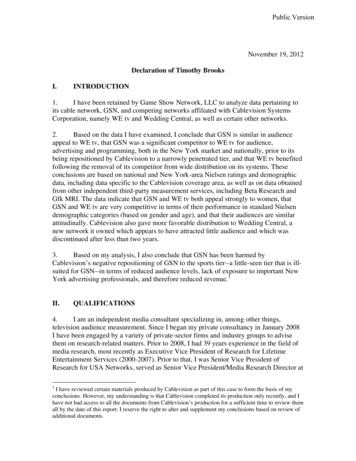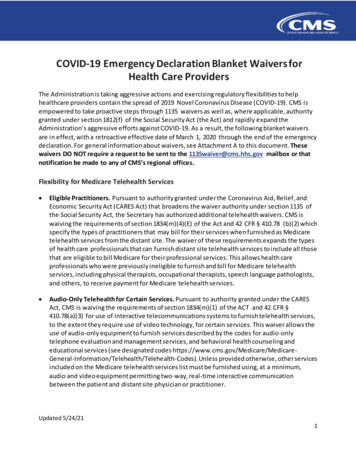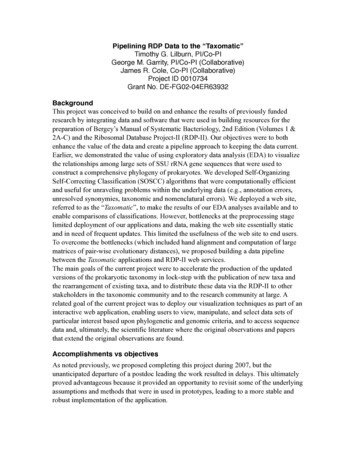
Transcription
Public VersionNovember 19, 2012Declaration of Timothy BrooksI.INTRODUCTION1.I have been retained by Game Show Network, LLC to analyze data pertaining toits cable network, GSN, and competing networks affiliated with Cablevision SystemsCorporation, namely WE tv and Wedding Central, as well as certain other networks.2.Based on the data I have examined, I conclude that GSN is similar in audienceappeal to WE tv, that GSN was a significant competitor to WE tv for audience,advertising and programming, both in the New York market and nationally, prior to itsbeing repositioned by Cablevision to a narrowly penetrated tier, and that WE tv benefitedfollowing the removal of its competitor from wide distribution on its systems. Theseconclusions are based on national and New York-area Nielsen ratings and demographicdata, including data specific to the Cablevision coverage area, as well as on data obtainedfrom other independent third-party measurement services, including Beta Research andGfk MRI. The data indicate that GSN and WE tv both appeal strongly to women, thatGSN and WE tv are very competitive in terms of their performance in standard Nielsendemographic categories (based on gender and age), and that their audiences are similarattitudinally. Cablevision also gave more favorable distribution to Wedding Central, anew network it owned which appears to have attracted little audience and which wasdiscontinued after less than two years.3.Based on my analysis, I also conclude that GSN has been harmed byCablevision’s negative repositioning of GSN to the sports tier--a little-seen tier that is illsuited for GSN--in terms of reduced audience levels, lack of exposure to important NewYork advertising professionals, and therefore reduced revenue. 1II.QUALIFICATIONS4.I am an independent media consultant specializing in, among other things,television audience measurement. Since I began my private consultancy in January 2008I have been engaged by a variety of private-sector firms and industry groups to advisethem on research-related matters. Prior to 2008, I had 39 years experience in the field ofmedia research, most recently as Executive Vice President of Research for LifetimeEntertainment Services (2000-2007). Prior to that, I was Senior Vice President ofResearch for USA Networks, served as Senior Vice President/Media Research Director at1I have reviewed certain materials produced by Cablevision as part of this case to form the basis of myconclusions. However, my understanding is that Cablevision completed its production only recently, and Ihave not had access to all the documents from Cablevision’s production for a sufficient time to review themall by the date of this report. I reserve the right to alter and supplement my conclusions based on review ofadditional documents.
Public VersionNW Ayer advertising agency, and held several research positions at NBC-TV, the NBCStations Division, and Westinghouse Broadcasting.5.I have taken a leading role in industry associations, serving as chairman of theboard of the Media Rating Council, which audits and accredits measurement servicesincluding The Nielsen Company, serving as chairman of the board of the AdvertisingResearch Foundation, which furthers the common research needs of media companiesand advertisers, acting as a founding member of the Council for Research Excellence,and in leadership roles on boards and committees of other industry associations. Icontinue to serve on a number of research-related industry committees. I have beenhonored with awards from several of these organizations, including a LifetimeAchievement Award (ARF, 2008) and an award for Excellence and Integrity in MediaResearch (CAB, 1995). I taught media research as an adjunct professor at C.W. PostCenter, Long Island University, for nine years. I have written several award winningbooks, including a standard reference book on television history, and am often quoted inthe press on research and programming matters. Recently I have served as an expertwitness on media research and related issues, including providing testimony in TheTennis Channel, Inc. v. Comcast Cable Communications, LLC (2011). My fullcurriculum vitae is attached.III.ANALYSIS OF WHETHER GSN IS SIMILARLY SITUATED WITHCABLEVISION-OWNED WE tv AND WEDDING CENTRALA. Description of Programming on Networks Analyzed6.I was asked to compare GSN with the Cablevision-affiliated WE tv and WeddingCentral networks, as well as with several other networks that are within GSN’scompetitive frame and are carried widely by Cablevision. 2 The following is a descriptionof the programming of GSN, WE tv, and Wedding Central. A fuller description of theiraudiences and discussion of program genres will appear later.7.GSN was launched in 1994 as “Game Show Network.” In 2004 the networkshortened its identification to “GSN,” in line with a move to broaden its programming toa wider range of women’s entertainment. Its programming consists primarily ofcompetition-based shows of various types, along with other reality-based programs, that,as discussed in additional detail below, appeal to an audience that is predominantlyfemale. Currently GSN features games in four broad categories, commonly known in theindustry as:(1) “Relationship games,” which focus on the contestants’ relationships. Theseinclude “dating games,” sexually charged games involving couples. GSN examples:Baggage, The Newlywed Game, Love Triangle. Each of the shows within GSN’s “Love2Wedding Central appears to have been quite similar to WE tv and GSN in terms of programming andtarget audience. However that network was not included in most of the Nielsen and other sources Iconsulted.2
Public VersionBlock” of programming falls within this category. Another type of relationship gameemphasizes families working together on challenges. GSN example: Family Feud.(2) “Celebrity games,” in which celebrities playing either alone or alongsideordinary people are a major part of the appeal. GSN examples: Match Game, 25,000Pyramid.(3) “Big money games,” often guessing games where a principal appeal is thepotentially large prize and the focus is on money. GSN examples: Deal or No Deal, 1 Vs.100.(4) “Quiz games,” in which the main appeal is the game itself, and the contestantrelies on factual knowledge and strategy. GSN examples: Card Sharks, Lingo, ChainReaction.8.There is variety in the appearance of GSN shows. Many of the hosts arecelebrities (Sherri Shepherd, Wendy Williams, Jerry Springer, Alfonso Ribeiro). Inaddition GSN carries series that are not traditional “games.” Over the years, GSN hasprogrammed more than 150 different series ranging from competition reality shows suchas The Amazing Race and, most recently, Dancing With The Stars, to reality showsfocusing on celebrities (Carnie Wilson: Unstapled) and weddings (Vegas WeddingsUnveiled). 3 It has also aired documentaries and, recently, a Drew Carey improvisationalcomedy show. The common theme is that the majority of GSN’s programming iscompetition-based with a predominant focus on women. Given this focus on the femaleaudience, it is not surprising that a number of core GSN programs overlap thematicallywith programming seen on other women’s networks, including WE tv, and would fiteasily into their lineups. For example, Love Triangle and Baggage are essentially real-lifetalk/relationship shows rather than traditional game shows.9.WE tv was launched in 1997 as Romance Classics, dedicated to romantic moviesand miniseries. In 2001 it was reformatted to include a broader range of women’sprogramming and relaunched as WE: Women’s Entertainment. In 2006 its name wasshortened to WE tv. Like GSN, WE tv targets women by airing a range of womenoriented programming. Its limited original programming consists primarily ofdocumentary-style reality-based shows such as Bridezillas, My Fair Wedding, TheCupcake Girls, Downsized, and Braxton Family Values. Many of these touch upon thesame themes as GSN’s relationship games -- dating, romance, and family dynamics. Ason GSN, celebrities have been featured on some WE tv series, among them Toni Braxton,gospel duo Mary Mary, Joan Rivers, Shannen Doherty, and comedian Sinbad. Theremainder of the schedule is filled with sitcom and drama reruns and a few movies. WEtv has also aired some competition shows similar to those on GSN, including Weight LossChallenge, Style By Jury, and Skating’s Next Star.10.In 2009, WE tv spun off a second women’s-oriented network called WeddingCentral, whose schedule consisted of reruns of wedding-themed programs that hadoriginally aired on WE tv. Cablevision gave Wedding Central preferential treatment via33
Public Versionwide distribution on its iO digital cable service 4 but it achieved little carriage from otherdistributors.The network wasshut down in 2011.11.I also considered GSN, WE tv, and Wedding Central within the context of otherwomen-targeted networks that are within those networks’ competitive frame and whichare widely carried by Cablevision, including Bravo, E! Entertainment, Hallmark Channel,Lifetime, Oxygen and OWN. 6 The following are brief descriptions of those networks’programming.Women’s Networks: Programming 7Bravo: Female-oriented documentary-style reality shows, including Kathy Griffin:My Life on the D-List, The Real Housewives, Millionaire Matchmaker, The Rachel ZoeProject, and an occasional movie. A significant portion of Bravo’s schedule has beendedicated to competition-based shows such as Top Chef. Much of its success in the mid2000s is attributed to the phenomenally popular competition show Project Runway,which Bravo aired from 2004 to 2008.E! Entertainment: Primarily celebrity-oriented reality shows, including KeepingUp with the Kardashians, Kendra, Chelsea Lately, and Fashion Police, plus somefemale-oriented reruns (e.g. Sex and the City) and movies.Hallmark Channel: Family-oriented reruns (Golden Girls, Frasier, I Love Lucy,Little House on the Prairie, The Waltons), family-friendly original and theatrical movies.Lifetime: General entertainment for women, including original drama and comedy(Army Wives, Drop Dead Diva, Sherri, Rita Rocks), as well as documentary andcompetition-based reality programs (Project Runway, Dance Moms). It also featuresreruns (Reba, Will & Grace, Desperate Housewives, Grey’s Anatomy) and original andtheatrical movies, many dealing with women’s issues. In the 1990s, Lifetime had a verysuccessful afternoon game show block, and during my tenure at the network (2000-2007),we had many discussions about restoring traditional game shows to Lifetime’s schedule.Oxygen: The edgiest of the women’s networks. Among its signature series areBad Girls Club (all-catfights-all-the-time), Love Games: Bad Girls Need Love Too (game4Thomas Ulmstead, “AMC Networks Divorces Wedding Central,” Multichannel News, 8 July 2011.Available at ion Launches Wedding CentralChannel.php. Accessed 11 September 2011.56Other female-skewed networks with which GSN and WE tv might be considered competitive includeStyle, Lifetime Movie Network, HGTV, TLC, and Food Network.7Tim Brooks and Earle Marsh, The Complete Directory to Prime Time Network and Cable TV Shows,1946-Present, Ninth Edition (New York: Ballantine Books, 2007), individual network entries; andwww.tvguide.com (accessed 25 September 2011).4
Public Versionshow spin off of Bad Girls Club), and Snapped (women who killed men). It featuresreality, competition, and documentary programs (Hair Battle Spectacular, Tori & Dean,Dance Your Ass Off) along with female-oriented theatrical movies and reruns. Sincebeing purchased by NBC, Oxygen has also aired reruns from its parent company (TheSing-Off, Law & Order).OWN: Oprah Winfrey’s recently launched network has focused on documentaryprogramming emphasizing self-improvement and spirituality for women. Among itsseries have been Oprah Behind the Scenes, The Judds, Dr. Phil, Gayle King, TurningPoint, Ask Oprah’s All Stars, and Celine Dion. It also airs a few female-orientedtheatrical movies.B. Comparison of GSN and WE tv Audiences12.In order to analyze the audience of GSN, WE tv and the other specified networks,I first requested that GSN provide me with data from The Nielsen Company. Reliableaudience data is in my view critically important to evaluate both the overall audiencestrength and the demographic skew of a network. This is a widely accepted premise in thetelevision industry. Indeed, virtually all presentations to advertisers and to MVPDs withwhich I was involved during my 40 years in the industry included such data, generallyfrom The Nielsen Company.13.Nielsen is the industry standard for measurement of television audiences in theUnited States. It is audited and accredited by the Media Rating Council (MRC), anindependent industry body consisting of buyers and sellers who use audience data. As aformer chairman of the MRC, I am quite familiar with Nielsen procedures and believe itsmeasurements to be impartial and accurate. Whether or not one shares that belief, it isclear that Nielsen is the dominant entity conducting television audience measurement inthe U.S. and its data are the basic currency of trade in the television advertisingmarketplace.14.Nielsen data in the form I required are available only to subscribing companiesvia specially installed computer access systems. I therefore specified to GSN researchpersonnel exactly what raw data I wanted accessed, and in what form. I received fromthem the data as produced by the access systems (e.g. the Galaxy and Arianna systems),in spreadsheet form. I conducted the additional analysis and calculations to prepare thisreport and the tables included herein.15.The Nielsen national ratings cited are coverage area ratings, the number of homesthat tuned to each network during an average minute as a percentage of homes thatreceive the network (i.e., the network’s “coverage area”). This is an accepted method ofcomparison for cable networks with different distribution and is widely used for nationalNielsen comparisons. Published New York market ratings are based on cable coverage8See e.g.5
Public Versionarea, since Nielsen does not provide network-level coverage ratings on a local marketbasis. Cable coverage area ratings reflect the number of homes tuned to a network as apercentage of all wired cable homes in the market, whether or not the home receives thenetwork as part of its MVPD service. In addition, in order to evaluate proprietary set-topbox data that Cablevision introduced before the Media Bureau, I asked GSN to provideme with Nielsen data, which is statistically more reliable than set-top box data,specifically limited to Cablevision’s coverage area (or “footprint”).16.In addition to Nielsen ratings, I used third-party data from Beta Research and GfkMRI to shed additional light on the relative popularity of the television networks inquestion. Beta Research is the leading provider of syndicated data measuring viewerattitudes toward cable networks. MRI is another widely used syndicated service thatreports, among other things, the broader attitudes of different networks’ audiences. I alsoaccessed certain publicly available information from the Internet and other sources. 9’17.My analysis of actual viewing audiences begins with national Nielsen data, thendrills down to available local data. 10 National Nielsen data (which is not available for allcable networks, but is available for GSN and WE tv) provides a valuable “big picture.”The large size of the national Nielsen sample () allows a morestable and in-depth analysis of audience demographics and a more accurate measure ofthe direction of ratings change and network potential than is possible with the smallersamples on which DMA ratings are based. 11 In this case,. Also, importantly, national Nielsen data rather than local data is used byadvertisers to determine whether to buy time on national networks such as GSN and WEtv.18.Next I looked at Nielsen ratings for GSN and its competitors in the New Yorkmarket, which is Cablevision’s “home” market, as well as Nielsen ratings limitedspecifically to Cablevision’s coverage area (or “footprint”). These localized Nielsenratings provide a more objective and reliable measurement of GSN’s popularity relativeto WE tv and other cable networks than does the set-top box data cited by Cablevision.9I also considered audience income data, which is available in different forms from Nielsen and MRI.Income is generally a factor only for upscale advertisers seeking networks that have high average incomeviewers. Such advertisers often use specialized services such as the Mendelsohn Survey of AffluentHomes to evaluate these networks. Income is not in my experience a factor generally used by advertisers inmaking purchases on other networks. According to the Nielsen and MRI data neither GSN nor WE tv is anupscale network.10Game Show Network, LLC v. Cablevision Systems Corp., Declaration of Timothy Brooks, October 10,2011. §§III.2.a, i [hereinafter Brooks Decl.].11A national vs. local analysis was valuable, for example, in establishing thatBrooks decl. §§ III.3.b,c.12Brooks decl. §III.2.l. ().6
Public Version(1) Nielsen National Ratings19.Total Audience Summary 13Total DayHH CVG RatingGSNWETotal DayPersons 2 CVG 2Y-T-D20.13147
Public Version2010 Total Day CVG Rating 15(Ranked on HH ratings)OverallRankNetworkHHPersons 2 21.Another important way to compare networks is to examine their demographics.This is what advertisers look at.2010 Total Day Audience Composition 16Adults(% of P2 )Women(% of adults)GSNWEBravoE!HallmarkLifetimeOxygenAll Networks22.It is well understood in the business that there are female-targeted networks,male-targeted networks, and general audience networks. I have had personal experiencein this regard, having among other things been head of research for Lifetime for eightyears. While no network is viewed 100% by a female or male audience, ad buyersnonetheless view networks as female or male-targeted and buy advertising inventory onthat basis. For example,15168
Public Version23.Advertisers look at demographic information, such as age, on the basis ofstandard Nielsen demographic categories. The four key categories for women’s networksare women 25-54, persons 25-54, women 18-49 and persons 18-49.GSN Advertising Sales Revenue (2010)24.Total Day Ratings 1925.26.Actual time purchasesmade by advertisers are made on the basis of delivery in thousands (or its equivalent,1718199
Public Versiontotal U.S. ratings 20). Any small deficiencies in delivery can be accommodated by havinga network provide an advertiser with somewhat more individual spots than its competitor,to make up any difference over the course of a full commercial schedule. Advertisers buygross rating points (GRPs) for a desired demographic, so a network that has slightlylower ratings in a particular demographic can easily remain competitive by simplyproviding more spots in order to deliver the desired GRPs in that demographic. 21 This isextremely common in the industry. In terms of the environment in which theadvertisements would appear,.27.28.It is important to base this type of analysis on shared viewing, not all viewing.Shared viewing is the percent of combined audience of two networks that watches both.20Total U.S. ratings are calculated on the basis of audience delivered divided by the total U.S. population inthat demographic.21Gross ratings points (GRP) is the mathematical total of the ratings of the individual spots in a commercialschedule. Thus if a network averaged a .10 rating among Women 18-49 and an advertiser bought tenWomen 18-49 GRPs, the network could deliver that by offering a schedule consisting of 100announcements. A competing network that averaged a .09 rating among Women 18-49 could deliver thesame ten GRPs by offering a schedule of 111 announcements. In fact, since r
its cable network, GSN, and competing networks affiliated with Cablevision Systems Corporation, namely WE tv and Wedding Central, as well as certain other networks. 2. Based on the data I have examined, I conclude that GSN is similar in au











